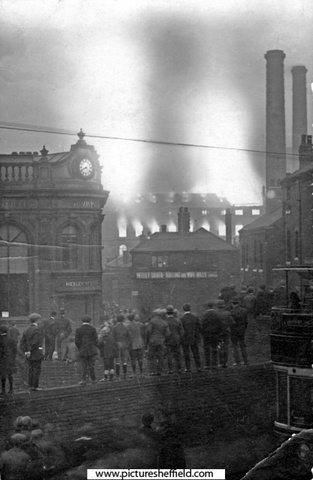As described in an earlier blog, visitors to the Northern Office in Sheffield often ask about the history of the Sheaf Bank Business Park. To help answer this, our two placement students from the University of Sheffield, Emma Hook and Sam Bromage, went to the local archives. Their research means that we now have an illustrated information poster which highlights the main events in the history of our office buildings.
The Sheafbank Works
In 1870 Charles Skelton (later Sir Charles) bought a former quarry cut into the hillside above the river Sheaf and next to the railway in Heeley, on the southern side of Sheffield. His company, C.T. Skelton & Co. Ltd, had been founded in 1855 to produce spades, shovels, picks and colliery tools and was originally located elsewhere in Sheffield.
At the new site he built the Sheafbank Works, with road entrances to both the ground and upper floors of the building from the top and bottom of the quarry. In this way he optimized the production flow in, through, and out, of the Works. Skelton’s became renowned for manufacturing spades, forks, shovels, small garden tools, garden shears and edge tools.
Sir Charles Skelton
Not only was Charles Skelton a successful businessman, he also took a leading role in Sheffield’s civic matters, serving on the Council for 33 years, being Mayor in 1894 and Deputy -Mayor in 1896. He received his Knighthood from Queen Victoria in 1897 during her visit to Sheffield. Sir Charles died in 1913 and his sons took over at the Sheafbank works.

The Great Fire of 1921
On 23rd April 1921 all but the forges at the Sheafbank Works were destroyed by Sheffield’s largest peacetime fire which resulted in £100,000 of damage. The fire is said to have been caused by sparks from a passing railway engine igniting the roof of the wood store and machine shops.
Despite the disaster, the company was so firmly established that it managed to rebuild the Works and to survive a slump in trade during the 1920s and 1930s.
Decline
However, Skelton’s was sold to Spear & Jackson in around 1959 and then merged to form Brades, Skelton and Tyzac in 1962, making garden, contractors and agricultural tools. Further mergers were unsuccessful and the factory at Sheafbank closed in 1967.
Present Day
In the later 20th century Skelton’s premises were occupied not by a single factory but by smaller operations. With the decline in manufacturing the building complex faced an uncertain future until it was purchased and leased out as individual premises within the newly named Sheaf Bank Business Park. Now home to Wessex Archaeology and a variety of businesses, including some metalworking and manufacturing firms, the industrial history of these buildings is clearly visible in their layout and fabric – making it a very suitable place for our Sheffield Office.
By Andrea Burgess, Project Manager, PX Analysis and Reporting